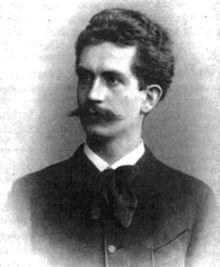Wilhelm Neumann-Torborg
Wilhelm Neumann-Torborg (born August 24, 1856 in Elberfeld (now part of Wuppertal ); † December 31, 1917 there ) was a German sculptor .
Life
Wilhelm Neumann-Torborg grew up in Wuppertal- Fingererscheidt as the son of a school principal. He attended evening courses at the royal provincial trade school in Elberfeld, where he received his first lessons in drawing and painting. From 1874 to 1877 he was an apprentice in Bad Kreuznach in the sculpture workshop of the brothers Robert and Karl Cauer (1828–1885). Further training followed. 1878 with Melchior zur Straßen at the Art Academy Leipzig and from 1880 at the Academy of Fine Arts Berlin with Otto Knille and Fritz Schaper .
In 1885 he received the Rome Prize of the Prussian Academy of the Arts for his thesis The Judgment of Paris . In the following years Wilhelm Neumann-Torborg lived and worked in Rome , where his wife, Emma Commichau, died after a short marriage. In 1892 the artist returned to Berlin .
During a visit to his hometown of Elberfeld he fell seriously ill and died in 1917. His grave is in the Lutheran cemetery on Hochstrasse in Wuppertal-Elberfeld.
Works
- 1884 The butterfly hunter
- 1885 The judgment of Paris , relief
- 1890 Psyche , marble statue
- 1890 Faun and Nymph , bronze
- 1897 Grave relief for the Richard Garschagen family, in the old Lutheran cemetery in Hochstrasse, Elberfeld
- 1903 Dörpfeld monument
- 1903 The Elberfeld Poor Care Memorial , bronze
- 1905 Colossal bust of Empress Auguste Viktoria (destroyed in 1943)
- 1911 bust of the Reinhart Schmidt memorial
Many of Wilhelm Neumann-Torborg's works were destroyed in the Second World War.
The Faun and Nymphe work was commissioned by August Freiherr von der Heydt . It survived the Second World War unscathed and has been on the Redoute in Bonn- Bad Godesberg since 1909 .
The Elberfeld Poor Care Memorial was also considered lost . In 2003, the granite base of the monument was rediscovered during excavations at the Elberfeld Old Reformed Church and erected in Blankstrasse (Wuppertal).
literature
- Ruth Meyer-Kahrweg : Monuments, fountains and sculptures in Wuppertal - biographies of the participating artists, Wuppertal 1991, p. 110ff.
- Cécile Zachlod: The Elberfeld Monument to the Poor in the Change of Monument Culture around 1900 . In: Geschichte im Wuppertal - 16th year, 2007, pp. 25–30.
Web links
Individual evidence
- ↑ Historical grave monuments of the Wupper region. Pp. 169–170 , accessed June 20, 2017 .
- ↑ Reinhart Schmidt Monument - Denkmal-Wuppertal.de. In: denkmal-wuppertal.de. www.denkmal-wuppertal.de, accessed on June 20, 2017 .
| personal data | |
|---|---|
| SURNAME | Neumann-Torborg, Wilhelm |
| BRIEF DESCRIPTION | German sculptor |
| DATE OF BIRTH | August 24, 1856 |
| PLACE OF BIRTH | Elberfeld |
| DATE OF DEATH | December 31, 1917 |
| Place of death | Elberfeld |

